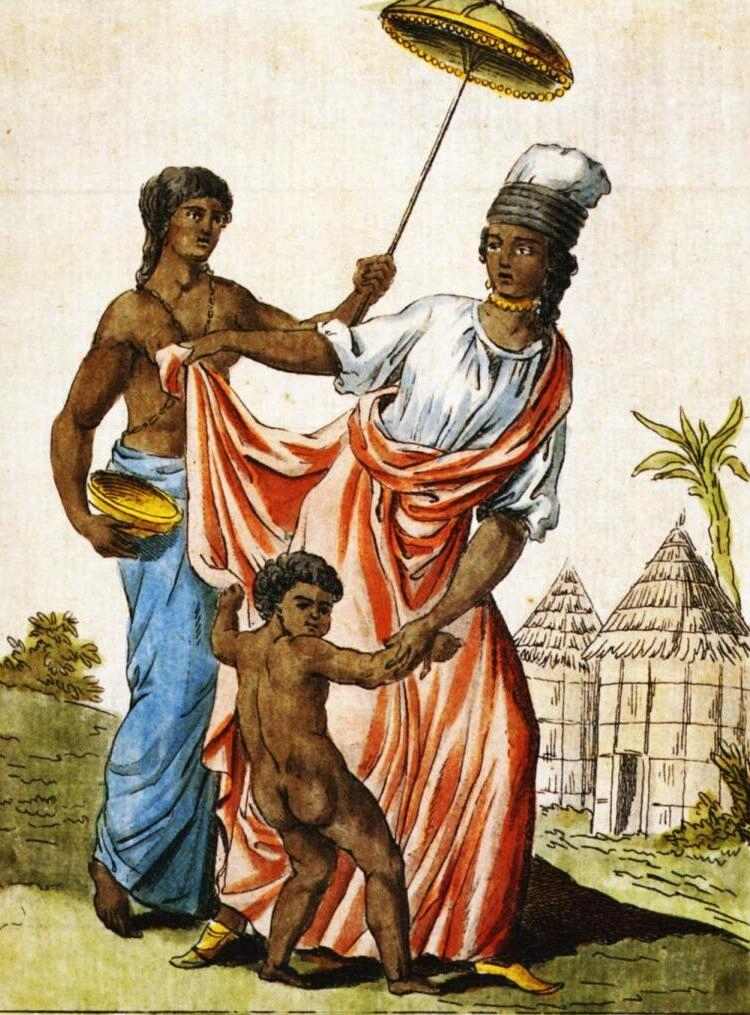
Senegalese History: French Colonia Era--Coastal Dominance (17th-18th Centuries)

Figure 1.--This is a drawing by Jean-Michel Moreau (1741-1814), a French draughtsman, illustrator and engraver. It probably dates to the late-18th century, probably while Senegal was under British control. Moreau's caption reads,
"Negresse de qualité de Isle St. Louis dans le Senégal , Accompagnée se son Esclave." That would translate as "Wealthy black woman from Island St. Louis in Senegal escorted by her slave". St. Louis was founded as a French trading post (1659). St. Louis became urbanised in the mid-19th century as France expanded its colonial effort in Africa. It became the capital of the French colony (1872-1957). Dakar is located on the mainland opposite St. Louisd. I don't know how accurate the clothing depiction is, however, Western-style fashion probanly did influence wealthy urban Africans.
The child could be the lady's child rather than another slave.
|
|
The European naval powers struugle with each other for areas of dominance along the African coast. The coast was vast so even decling powers like Portugal were able to dominate sdome iof the coast. Spain was primarily interested in the America. The British and French were the major competitors in West Africa, Eventually the French established a trading post at St Louis (1659). This was the beginning of Senegal as a French colony. The principal commercial interest became captured Africans that could be enslaved and sold (late-17th through the early-19th century). St. Louis and the French slave trade was relatively small compared to the other major countries (England, the Netherlands, and the Portuguese). This was in part because of the relatively small French Empire in the Caribbean and South America. And for political reasons, the French were unable to sell to the English colonies. The major African ports from which slaves wre shipped were located in the Gulf of Guinea to the south of Senegal (Ghana east to the Cameroons) which were mostly controlled by the British, Dutch and the Portuguese. France and the other countries did not move into the interior, but well relations with native rullers able to supply captives for colonial plantations in the Americas in need of labor. Plantations in Haiti, for example, were hugely profitable and demanded large numbers of slaves. The political situation in Senegal and the rest of West Africa was complicated by competitions betweem African rulers anxious to control the slsve trade as well as Arab incursiond from the north across the Sahara. Rather than slaves, French traders dealt with a range of commodities like gum arabic, groundnuts (or peanuts) and other raw materials from the interior regions. The British gained control as part of the settlement if the Seven Years War (1763).
HBC

Navigate the Boys' Historical Clothing Web Site:
[Return to the Second French colonisal empire]
[Return to the Scramble for Africa: France]
[Introduction]
[Activities]
[Biographies]
[Chronology]
[Cloth and textiles]
[Clothing styles]
[Countries]
[Topics]
[Bibliographies]
[Contributions]
[FAQs]
[Glossaries]
[Images]
[Links]
[Registration]
[Tools]
[Boys' Clothing Home]
Navigate the Boys' Historical Clothing national pages:
[Return to the Main Senegal French colonialm page]
[Return to the Main Senegalese history page]
[Return to the Main African country history page]
[Return to the Main African page]
[Angola]
[Cape Verde Islands]
[Democratic Republic of the Congo]
[Ethiopia]
[Gabon]
[Gambia]
[Guinea]
[Guinea-Bissau]
[Madagascar]
[Mali]
[Mauritania]
[Nigeria]
[Senegal]
[Somalia]
[South Africa]
[Uganda]
Created: 9:26 AM 3/14/2011
Last updated: 9:26 AM 3/14/2011



